Safe and Healthy Return to Sport
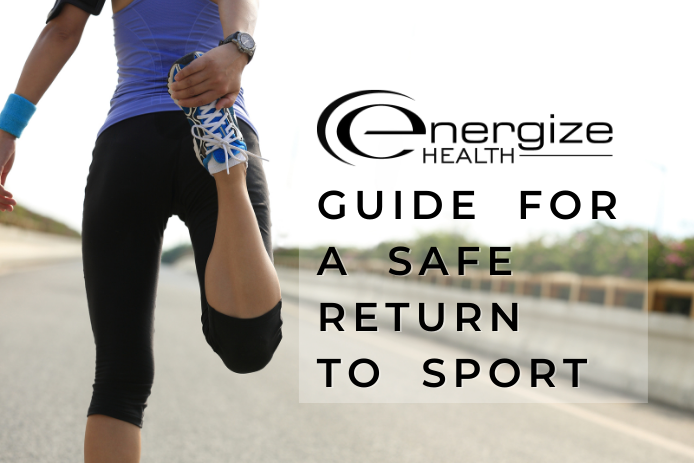
Written for by Dr Nicole Barry, D.C. and Kevin Connell, P.T. of Energize Health
Starting a new season can be an exciting time, especially after a year like we have all had! It can also be a time where the likelihood of injury is higher, due to our bodies not being used to the demands of the sport. With this in mind, we have created a simple outline, focusing on 3 key areas, to prepare your body for a safe and healthy return to softball. Let’s get into it!
Tip #1: Easing Your Way Back into Sport
Out of all the areas of focus discussed here, this is by far the most important. No matter how strong your body is, how warmed up you are, or how great your daily habits are, the rate at which you return to your in-season level of play will have a major role in how likely you are to become injured. While there are general exercises and stretches we can do before the season starts to prepare our muscle and joints (covered in the next tip), they are no substitute for the actual movements and actions of your sport like throwing, batting, sprinting etc. This is why it’s important, before the season even starts, to get outside and start practicing some of these specific skills at a lower intensity and lower number of repetitions than typically expected while in-game. Once you are out there, start with just a small number of light throws, light batting practice, and some light running to get a feel for how your body responds. The next day, if it’s been a while since you last practiced these things, you may notice your muscles are a bit sore and that’s OK! Once that soreness has disappeared (if you had any), get back out there and do bit more throwing, batting, and running than last time. Continue with this routine until you are at or close to the intensity and number of repetitions expected during your season. This is an amazing way to prepare your muscles and joints for the stresses placed on them from softball, therefore reducing your chances of getting hurt.
Tip #2: Strengthening, Stretching, and Warmups
Now that we’ve covered how to slowly reintroduce specific aspects of softball in order to prevent injury, we can now talk about things you can do more generally, to prepare and strengthen your muscles and joints. Depending on an athlete’s age and skill level, strengthening exercises can be implemented either year-round or leading up to the season as a great way to prevent injury. Stretching is also an important factor to consider, as well as a thorough warmup before practices, games, and workouts. This section can be broken down into two parts: upper body and lower body preparation.
- Upper Body Preparation
In softball, unlike sports without throwing involved, there are high demands placed on the upper body, especially for pitchers. Therefore, it’s important to both stretch and strengthen the muscles of arms, shoulders, back etc. Here are a couple of examples of some exercises you can try. This is not an exhaustive list by any means and be sure to avoid any of the ones listed if they cause any sort of pain. Just like we mentioned in the first point with easing back into softball, it’s important to ease into these as well to avoid over-working the area.
Shoulder Circles
- These are great as a warmup before any sort of throwing, batting, or strengthening
- Start slow and controlled and then gradually build up the speed
- Can be done both forwards and backwards
- Complete approximately 20-30 repetitions each way
Thread the Needle
Here is a great stretch to improve the range of motion of our trunk rotation which is very important in both throwing and batting, as you can imagine!
- Starting on all 4’s, begin by reaching one arm between your other arm and leg as far as you can
- From here, bring the arm back through and reach up towards the ceiling as far as you can
- Repeat 10-20 times per side


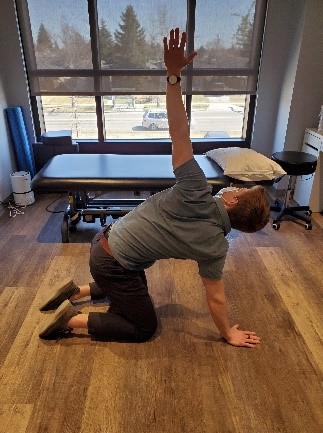
Shoulder Circles with a Resistance Band
This acts as both a stretch and strengthening exercise which is why we like it so much!
- Using a light resistance band held in each hand, slowly perform shoulder circles with as much range of motion and tension as you feel comfortable
- Start with just 1-2 sets of 10-15 repetitions to assess tolerance and build up from there

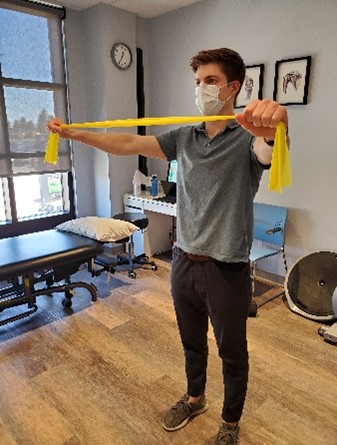

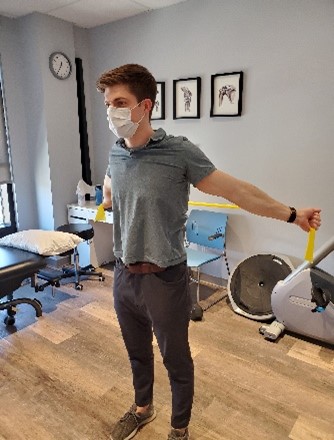
Face Pulls
This is a great way to strengthen the rotator cuff and other various muscles that surround the shoulder joint which is especially important for throwing strength and injury prevention.
- With the band anchored in the middle to the wall around eye level, begin with arms straight
- Pull back with both arms, squeezing the shoulder blades together and trying to get both your elbows and hands as far back as they go
- Return to arms straight out in front of you before beginning the next repetition
- Again, start with just 1-2 sets of 10-15 repetitions and build up from there
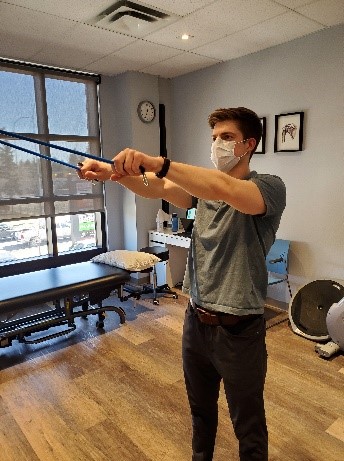

B. Lower Body Preparation
Core
Your core is often misrepresented as just the abdominal muscles, but in reality, it is so much more! Your core is an intricate system that includes abdominals in the front, erector spinae muscles and glutes in the back, and the diaphragm, pelvic floor and hip girdle musculature as the top and bottom. Your core is important to help stabilize/protect your spine as you move. Better core movement will help your spine to move less and transfer greater force through your arms or legs, ie. helping you to swing the bat with more power or run faster.
Legs
Softball requires a lot of stop and go movements. Being able to take off in a burst of speed around the bases requires explosive power through the hips and fast footwork. Dynamic stretching can be a great way to improve range of motion of the hips and get the muscles better primed up for activities.
Listed below are a few exercises that incorporate stretching, mobilizing and strengthening the legs and core.
World’s Greatest Stretch with Hamstring Stretch:
- Lunge forward with your right leg, and as you move down into the lunge, place your left hand on the floor so it’s even with your right knee.
- Begin to twist to the right as you reach your right arm up and out to the sky. You can turn your head and neck following your right arm upwards. Hold in this position for 8-10 seconds/ or as long as you need.
- Return back to a forward lunge, then straighten your right knee to stretch your hamstring. Hold for another 5-10 seconds.
- Return to the starting position and repeat on the left leg.



Knee Hug to lunge:
- Bring your right knee up to your trunk for 1-2 seconds. Release and step forward into a lunge with the right leg.
- Return to the starting position and repeat on the left side.

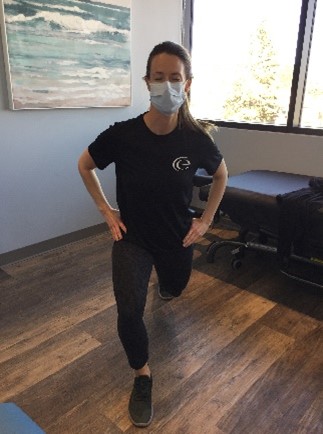
Quick feet forward/backwards:
Move feet forward and backward over an imaginary line. Aim to do 20 reps per side, you can also repeat moving feet in/out as well. Start slow to get a good rhythm and gradually increase speed.
Pallof Press:
- Grab a theraband and tie it around a pole or secure it to the hinge of a door. If you are at the gym, you can use a cable at chest to shoulder height, and keep the weight very low.
- Step an arm’s length away and assume an athletic stance, with feet shoulder-width apart and knees slightly bent. Squeeze your glutes to stabilize your pelvis. Hold the band/cable at the level of your sternum.
- To begin, slowly extend your arms out and pause for 1-2 seconds, and then slowly bring them back to starting position. Repeat 5 times per side, for 3 sets total.


Tip# 3 Start with good nutrition and sleep
Getting a good night's rest is one of the best things you can do to optimize your strength, speed and reaction time. While you're sleeping, your body is working hard to repair muscles, strengthen your immune system, and improve overall brain function.
Having trouble getting to sleep? Try some of these tips:
- Turn off computer or phone an hour before bed
- Sleep in cool, dark environment
- Aim to get 8-10 hours of sleep
- Try a warm bath or shower before bed to relax
- Set a regular time to go to bed and wake up
In addition to sleep, nutrition is another important factor for optimizing sports performance. As recommended by the Canadian Pediatric Society, a well-balanced diet should contain macronutrients such as carbohydrates, protein and fats, as well as micronutrients such as vitamins and minerals. A few things to keep in mind for nutrition:
- Try to include complex carbohydrates that are slower to digest and provide a more stable form of energy. These can include brown rice, legumes, whole grains, and sweet potatoes.
- Make sure to get enough protein. According to Stamford Health young athletes can require between 1.2-1.8 grams per kilogram of body weight
- Limit highly processed foods, especially fried foods that are high trans fats. Try to include mono-saturated and polyunsaturated fats such as nuts, seeds, salmon and avocados.
- Stay hydrated! Try to stay away from sugary sports drinks with electrolytes and instead opt for using a squeeze of lemon, pinch of salt, an electrolyte tablet, or coconut water.
A great guide for information on sports nutrition for young athletes can be found through Alberta Health Services: https://www.albertahealthservices.ca/assets/info/nutrition/if-nfs-sports-nutrition-for-youth.pdf
We hope you find benefit from these tips as you resume softball this season and for many years to come. If you have any questions or if we can be of any assistance, please reach out. Best wishes for an awesome, injury-free season, SBR!
- Dr Nicole and Kevin
About the Authors

Nicole Barry, Chiropractor (Energize Health South)
Dr. Barry has always maintained a passion for health and fitness, participating in variety of sports from a young age. Her enthusiasm for an active lifestyle has given her the opportunity to connect and work with athletes of all ages. While many people associate adjustments with chiropractic care, that is just one of the tools in her toolbox. Dr. Nicole employs a combination of soft tissue therapies, adjustments, gentle joint mobilizations, kinesiology taping, and rehabilitative exercises to help her athletes recover and function at their best.
Book online with Dr Nicole Barry at our south Calgary location

Kevin Connell, Physiotherapist (both Energize Health North & South)
Kevin is physiotherapist who has been a lifelong athlete. From baseball, soccer, and football to track and field and even competitive badminton, he has extensive experience in a wide range of sports. With time spent as a coach, personal trainer and now physiotherapist, he has a passion for helping those who are dealing with pain and injury from a sport and for those who want improve their ability and performance.
Book online with Kevin at our south Calgary location. Book online with Kevin at our north Calgary location.
Archive
- ► 2024 (5)
- ► 2023 (4)
- ► 2022 (9)
- ► 2021 (5)
- ► 2020 (5)
- ► 2019 (5)
- ► 2017 (5)
- ► 2016 (5)
